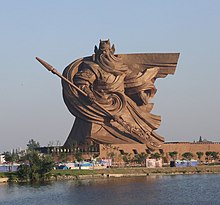
Hubei is an inland province of China, and is part of the Central China region. The name of the province means "north of the lake", referring to its position north of Dongting Lake. The provincial capital, Wuhan, serves as a major transportation hub and the political, cultural, and economic hub of central China.
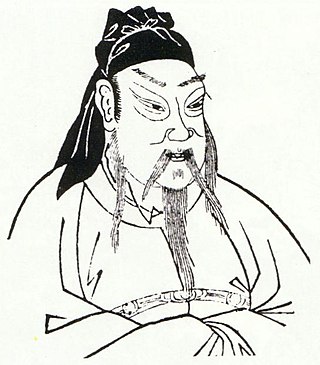
Guan Yu, courtesy name Yunchang, was a Chinese military general serving under the warlord Liu Bei during the late Eastern Han dynasty of China. Along with Zhang Fei, he shared a brotherly relationship with Liu Bei and accompanied him on most of his early exploits. Guan Yu played a significant role in the events leading up to the end of the Han dynasty and the establishment of Liu Bei's state of Shu Han during the Three Kingdoms period. While he is remembered for his loyalty towards Liu Bei, he is also known for repaying Cao Cao's kindness by slaying Yan Liang, a general under Cao Cao's rival Yuan Shao, at the Battle of Boma. After Liu Bei gained control of Yi Province in 214, Guan Yu remained in Jing Province to govern and defend the area for about seven years. In 219, while he was away fighting Cao Cao's forces at the Battle of Fancheng, Liu Bei's ally Sun Quan broke the Sun–Liu alliance and sent his general Lü Meng to conquer Liu Bei's territories in Jing Province. By the time Guan Yu found out about the loss of Jing Province after his defeat at Fancheng, it was too late. He was subsequently captured in an ambush by Sun Quan's forces and executed.
Chen Youliang was the founder and first emperor of the dynastic state of Chen Han in Chinese history. He was one of the military leaders and heroes of the people's revolution at the end of the Yuan dynasty.

Jingzhou is a prefecture-level city in southern Hubei province, China, located on the banks of the Yangtze River. Its total residential population was 5,231,180 based on the 2020 census, 1,068,291 of whom resided in the built-up area comprising two urban districts.

Liu Zhang, courtesy name Jiyu, was a Chinese politician and warlord who served as provincial governor who lived in the late Eastern Han dynasty of China. He became the Governor of Yi Province, succeeding his father Liu Yan and ruled the region until 214, when he surrendered to Liu Bei. Six years later, Liu Zhang again surrendered to Eastern Wu, and died shortly afterwards. Liu Zhang is often considered an incapable leader but is noted to have been the original lord of some of Shu Han's most famous generals and officials such as Fa Zheng, Meng Da, Zhang Ni, Liu Ba, Huang Quan, Wu Yi, Li Yan, Dong He and others.
Liu Yan, courtesy name Junlang, was a Chinese politician and warlord who lived in the late Eastern Han dynasty of China. He was also a member of the extended family of the Han emperors. For most of his career he served as the governor of Yi Province, which he developed into an independent power base. His domain was passed on to his son Liu Zhang, and eventually to Liu Bei, who founded the state of Shu Han during the Three Kingdoms period.
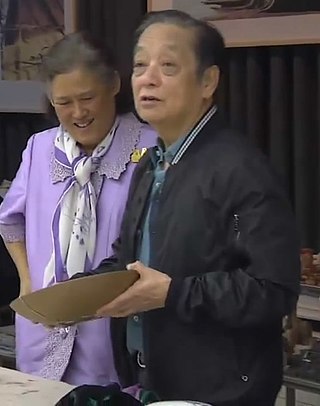
Han Meilin is a Chinese artist most recognized today for his creation of the Fuwa dolls for the 2008 Summer Olympics in Beijing.
The Battle of Jiangling was fought by the allied forces of Sun Quan and Liu Bei against Cao Cao during the late Eastern Han dynasty of China. The battle was an integral part of the Red Cliffs campaign, and was fought immediately after the Battle of Yiling in 208, and the preceding engagement at Wulin on land and the marine Battle of Red Cliffs where Cao Cao's navy was destroyed. Note that the battle at Wulin was a byproduct of the Battle of Red Cliffs, and they were not the same battle.
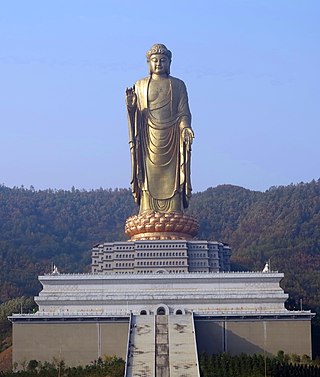
The Spring Temple Buddha is a colossal statue depicting Vairocana Buddha located in the Zhaocun township of Lushan County, Henan, China, built between 1997 and 2008. It is located within the Fodushan Scenic Area, close to National Freeway 311. At 128 metres (420 ft), excluding a 25 metres (82 ft) lotus throne, it is the second-tallest statue in the world after the Statue of Unity in Gujarat, India, which surpassed it in 2018 with a height of 182 metres (597 ft).

Huitong County is a county of Hunan Province, China, it is under the administration of Huaihua Prefecturel-level City.
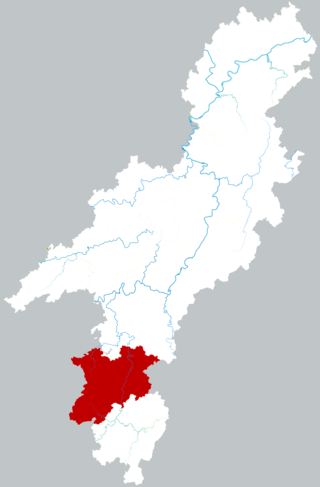
Jingzhou Miao and Dong Autonomous County, usually referred to as Jingzhou County or abbreviated just as Jingzhou, is an autonomous county of Miao and Dong peoples in Hunan Province, China, the county is under the administration of the prefecture-level city of Huaihua. It was known as "Jing County", renamed to the present name on February 19, 1987.

Guan is a Chinese surname. Guan is 394th in the Hundred Family Surnames.
Lady Guan, referred to as Guan Yinping in folktales, was a Chinese noblewoman from the state of Shu Han during the late Eastern Han dynasty and the Three Kingdoms period. She was the daughter of Guan Yu, a prominent general under Liu Bei, the founder of Shu Han state.

Guokui, literally "pot helmet", is a kind of flatbread made from flour originating from Shaanxi cuisine.
The Sun–Liu territorial dispute was a military conflict between the warlords Sun Quan and Liu Bei in 215 during the late Eastern Han dynasty of China. While Sun Quan and Liu Bei had initially formed an alliance in 208 against their common rival Cao Cao, both sides got into a territorial dispute over the territories in southern Jing Province in the early 210s. The dispute ended when both sides agreed to divide the territories along the Xiang River between their respective domains: Sun Quan took the lands east of the river while Liu Bei kept those west of the river. Despite a peaceful settlement to the territorial dispute, Sun Quan ultimately sent his forces to attack Liu Bei's territories in an invasion in 219 and succeeded in capturing all of them.
The Chang Lake, originally known as Wazi Lake, is a lake located at the junction of Jingzhou, Jingmen and Qianjiang, central China's Hubei province. It is the third largest lake in Hubei. The lake has an area of 122.5 square kilometres and a capacity of 271,000,000 cubic metres. The lake discharges into Jing River.

In East Asian Mahayana Buddhism, the Sangharama are a class of deities who are guardians of Buddhist temples and monasteries. Equivalent to the Taoist "realm master deity" (境主), the Sangharama are considered the lowest class of Dharmapala. The Sangharama deities are dedicated to protecting the monastery area and all who practice within them.

The ancient city of Jingzhou, known as the Ancient Jiangling City, is located at Zhangjuzheng Street, Jingzhou District, Jingyang City.
Lu Shuming was a Chinese actor best known for his role as Guan Yu on the 1994 television series Romance of the Three Kingdoms, and also garnered recognition for his roles as Bull Demon King and Li Guang on A Chinese Odyssey (1995) and The Emperor in Han Dynasty (2005), respectively.
